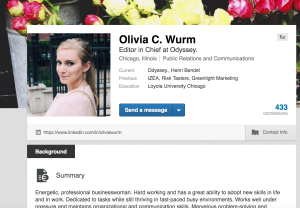Launching in 2003, as a business-oriented social network service, LinkedIn is used for professional networking and as an online job research tool for people entering and in the workforce. As an upcoming young woman in the workforce, I have found myself signed into LinkedIn for several hours of the day. Whether those hours consist of finding people I know, looking up new companies to follow, or searching new jobs in general, LinkedIn has a plethora of different opportunities when it comes to facilitating a career.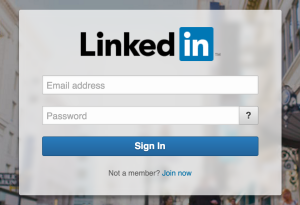
So, let’s break it all down and find out a little more into how LinkedIn can serve you.
The Profile
The profile is the first and most important step in getting started on LinkedIn. This is essentially your resume, but a little more “jazzed up” and explained. The profile is a similar function across many social media platforms; however, on LinkedIn, it is vitally important to stay professional, but true to yourself. And, as every tip and trick from business sources across the internet can attest to, the profile is your first impression on a desirable company.
Basics of the Profile
Photos: gives you a humanistic approach to this online resume tool that you might not have been able to have on a printed resume. For example, I chose a picture that is recognizably me, not too cluttered with other people or objects in the background. For the profile background image (optional), I decided to add a touch of my own photography, featuring a subject I photograph well, flowers.
The Summary: a “mini cover letter,” explaining who you are (aside from the education and job experiences) and what kind of worker or person you are as a whole. This summary area on your profile could also tell employers you are looking for a job, allowing them to potentially put you at the top of the list, knowing that you are interested. For my profile, I decided to put in skills that past interviewing employers have asked me, proving that I have these skills before a future employer is to ask me during an interview; this also is a reference for an interviewer to bring up as talking points.

Experiences: arguable my favorite part of LinkedIn and almost feels like a game when entering everything in, especially if you are a go-getter or over achiever, like me. Having all of your job experiences on your LinkedIn gives the audience a reference of what you know thus far. The reason this section is my favorite on a profile is because LinkedIn does such a great job breaking down the different elements in a job and lets people show as little or as much as desired.
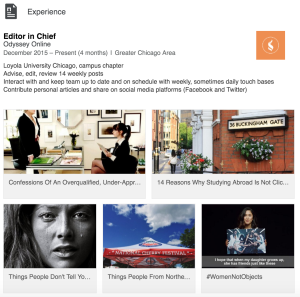
For example, my most recent and current experience is working for the Odyssey Online, an online social content platform. As the Editor-in-Chief of the Loyola University Chicago chapter, I not only write my own pieces, but edit all of my staff writers’ pieces, as well. Because this is a big job and requires a lot of commitment and dedication, this is an experience that I want to highlight with pieces of my work, not only the job description. Providing the ability to include a document, photos, links, a video, or a presentation to a job description shows that you have actually done something in the position, which is what future employers are looking to see, how you are beneficial in a company and how you will be beneficial to them if hired.
Language: something that tells employers in this day-in-age that you stand apart from the rest. Whether you only know one additional language from your native language, or speak 17 other languages, this section on a LinkedIn profile can set you apart from the competition. Language can enhance your work ethic and has shown to help people gain promotions and awards in companies. Even if you only know a little bit of a foreign language, it’s important to include. It could be the difference that sets you apart from the rest.
Education: a necessary part of a LinkedIn profile. This has the ability to connect you with alumni groups (another perk of LinkedIn), shows how many alumni from your school a particular company has (which could make you not want to work there), and is necessary to prove you have been educated.
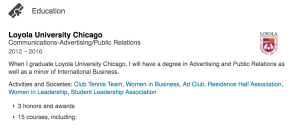
What I value about the education section on LinkedIn is that they not only allow you to tell what you’re majoring/minoring in, and the expected graduation, but to provide the honors/awards you’ve won and the courses you have taken throughout your time at this institution. To be honest, I didn’t realize I could do this until recently. I think the most effective way to include your coursework onto your profile is by putting courses on that you would be willing to talk about in an interview or if someone were to ask why those were crucial in developing your education.
Skills: exactly what it sounds like, your skill set. Adding in your skills to the profile shows what you have learned from all of your experiences, education, etc. When it comes to skills, it’s time for you to shine! The best part about the skills section is that other people-colleagues, classmates, professors, bosses, anyone-can “endorse” you for a skill you have. For example, people I have work with in the past endorsed me for my customer service, knowing that I have that skilled because they saw it implemented when we would work together.
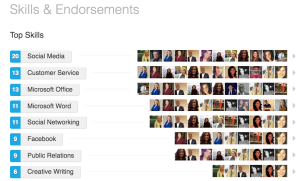
LinkedIn is a brilliant tool in this strenuous job market because it is a way to brand and set oneself apart from the rest of the applications in the pile. If you already have a LinkedIn, keep enhancing it! Make sure that your skills and endorsements at the top are the ones you really want employers seeing, and don’t be afraid to ask people for endorsements and recommendations. Recommendations are still helpful when going into interviews, so take advantage of all that LinkedIn has to offer.
https://youtu.be/j5Oar6SsxOY
